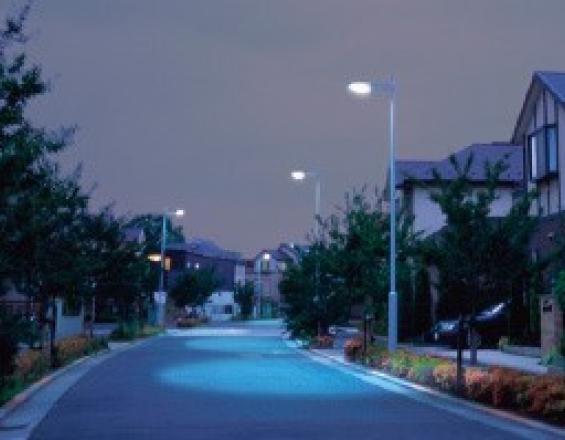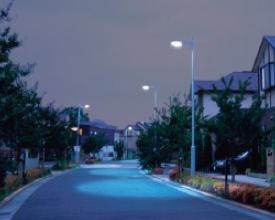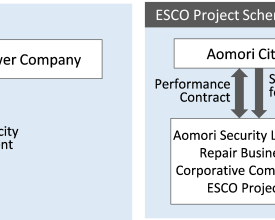
Energy-efficient Street Lighting for Safety and Urban Design

Hirosaki City and Aomori City in Tohoku, Japan, faced challenges to improve security and energy-efficiency on streets. They have been proactively replacing conventional streetlights with LEDs since 2010. Due to the limited budget, the cities adopted an Energy Service Company (ESCO) model for installing, maintaining, and financing the LED street lighting service. This model allows local governments to benefit by commissioning the energy service to private business operators through an energy saving performance contract.
Context
Challenges addressed
The Great East Japan Earthquake in 2011 caused serious power shortage across east Japan due to nuclear power plants damaged by Tsunami. This experience of local governments highlighted the importance of saving energy in a wide range of public facilities. At the same time, street security and safety are always concerns in communities. The local governments essentially need to ensure street safety while saving the lighting energy.
Location
Process
Summary of the process
LED light is an energy-efficient alternative for street lighting with lower environmental footprint. Both of the city governments proactively replaced street lights with LEDs by applying an ESCO scheme. Two major factors among others pushed the governments to initiate the ESCO projects: 1) electric power companies lowered electricity charge of LEDs, 2) management companies and LED manufacturers innovatively retrofitted LED lights to meet the regional needs.
Building Blocks
Upgrading to Cost-effective, Energy-efficient Street Lighting through an ESCO model
An ESCO model includes a scheme whereby a reduction in energy expenses compensates costs to install energy saving equipment/facilities. Adopting this business model, Hirosaki City commissioned a local electronic company association to replace the streetlights with LEDs and maintain them for ten years. The commission fee to the local electronic company association was JPY 340 million for ten years.
Before the projects, neighborhood associations owned the streetlights while the city government provided a subsidy, which was 7% of the annual electricity fee, for electricity and some repairs to neighborhood associations. Thus, neighborhood associations had to pay for the rest of repairs. In this ESCO project, however, neighborhood associations granted the ownership to the city for free. Utilizing the ESCO scheme, the city converted all 17,800 streetlights to energy-efficient LEDs.
Enabling factors
- Transferring the ownership of street lights from neighborhood associations to the city government
- Entrusting management of street lights to a private company association for more energy-efficiency.
Lesson learned
By this ESCO scheme, the city government successfully reduced a considerable amount of energy cost while ensuring safety and security on the streets. The ESCO business makes it possible to maintain the same quality of service while contributing to savings and energy conservation.
Lowering Electricity Price of LED lights
In December 2011, major electric power companies in Japan established a new pricing for streetlights lower than 10 watts. For example, 20-watt fluorescent lights cost JPY 169 monthly, whereas 10-watt LEDs cost JPY 120 monthly. This price difference makes the proliferation of LED streetlights more beneficial.
Enabling factors
-
A new electricity pricing system catered to LED users
Lesson learned
Changes in electricity price significantly increase or decrease running cost of public lighting facilities. Lowering the price for facilities with small energy consumption like LED lighting pushes individuals, communities, and governments to replace old facilities with energy-efficient alternatives.
Customizing Devices to Meet Regional Needs
The greatest challenge in introducing LED streetlights was posed by heavy snow in the region. Since LEDs are less luminous, they emit less heat than other lights. Thus, snow sometimes covers the lights and does not melt. This leads to an unsuitable situation with regards to security. To address their particular snow problems, the energy association and light manufacturers invented dark LEDs specifically customized for Hirosaki City.
Enabling factors
- Customizing street lights with special features to solve a problem caused by reginal characteristics.
Lesson learned
The ESCO business provides customers with comprehensive services on energy-saving with the expertise in energy business. Their services include energy-saving diagnosis for factories and buildings, design and construction/installation, maintenance and operation management of facilities, and procurement of business funds. Through the holistic energy use management, ESCOs address regional or individual problems and reduce the total energy cost.
Impacts
Economic Impact: As a result of this implementation, the city government’s electricity bill fell by JPY 30 million annually, which is a saving of JPY 9 million. Additionally, the neighborhood association does not need to pay for maintenance. For example, before the project, the city had a budget of JPY 72 million for streetlights. However, after the project in 2014, the total budget was reduced to JPY 67 million (JPY 33 million for electricity and JPY 34 million for commission).
Social Impact: This project installed 138,000 LED streetlights. Since LEDs save on lighting costs, the saved costs are now spent on maintenance for the lights. In addition, LED streetlights are brighter than conventional lights, thereby working to prevent crime and are believed to increase safety in communities. It is also expected that brighter streets would increase visibility for drivers and pedestrians, especially at night, eventually leading to a decrease in traffic accidents.
Environmental Impact: LEDs use only 30% of the electricity consumed by conventional lights. This project resulted in a decrease of 1,236 tons of CO2 annually. In addition, the increased brightness of the streets is expected to ensure a cleaner environment for cities because people tend to avoid littering in brighter streets compared to darker ones.
Beneficiaries
- Residents of Hirosaki City and Aomori City
- Private companies in Hirosaki City and Aomori City

